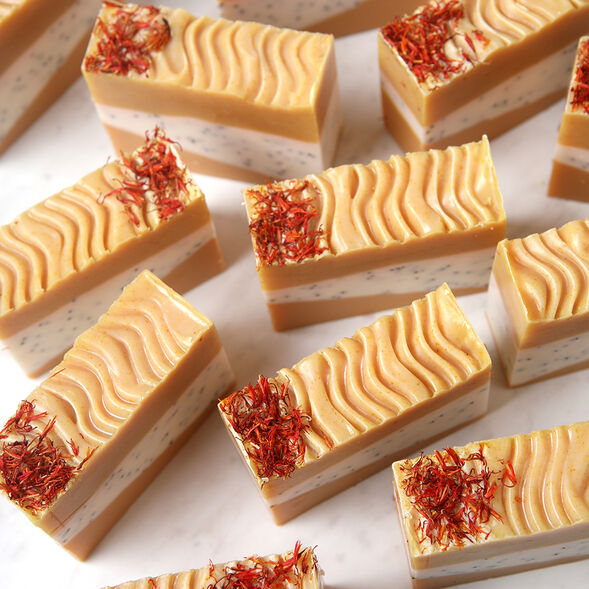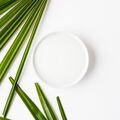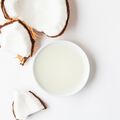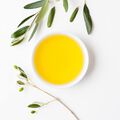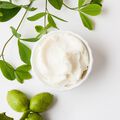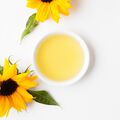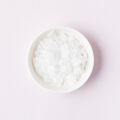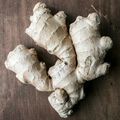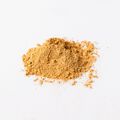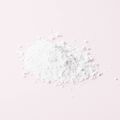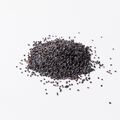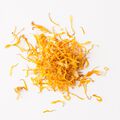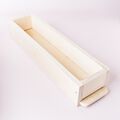
Safflower and Ginger Soap Project
- Skill Level: Advanced
- Time:
- Yield: About 5 pounds of soap
Project Description
Safflower is a thistle-like plant with a variety of uses. The crop is used to make oil, dyes, and more. In this soap, safflower petals are sprinkled on top for a pop of color and texture.
The layered design requires a good understanding of soap texture, also known as trace. To create a diagonal layer, the mold is propped up on one side and the soap is allowed to harden in the mold. Once it’s firm enough, the mold is set evenly on the counter and the remaining soap is layered on top. This requires the second and third layer of soap to stay thin and workable while the bottom layer hardens.
The ginger essential oil aids in the layering process. Because it accelerates, it helps the soap harden faster. The oil is added to each layer right before it’s poured into the mold, which creates firm bottom layers that are not disrupted as easily by the soap on top.
If you don’t have experience creating layers in cold process, we recommend getting a few basic layering recipes under your belt first. A good option is the Pink Salt & Gold Cold Process Soap. It has uneven layers, which are much easier to create. Even with lots of practice, we have a hard time making 100% straight layers – you’ll notice they’re not perfectly even in these bars.
This recipe does contain a very small amount of ginger essential oil. Because it’s an expensive essential oil, we used the smallest amount possible while still being able to smell it in the final bar. The amount in this recipe does give a light ginger scent. If you want a stronger scent, feel free to use more according to the Bramble Berry Fragrance Calculator.
You will need:
- 5 Pound Mold with Sliding Bottom
- Silicone Liner for 5 lb. Wood Mold
- 12.8 oz. Babassu Oil (25%)
- 10.2 oz. Coconut Oil (20%)
- 15.3 oz. Olive Oil (30%)
- 2.6 oz. Shea Butter (5%)
- 10.2 oz. Sunflower Oil (20%)
- 7.4 oz. Sodium Hydroxide Lye
- 15.2 oz. Distilled Water (10% water discount)
- 1 oz. Ginger Essential Oil
- Yellow Brazilian Clay
- Titanium Dioxide
- Poppy Seeds
- Safflower Petals
FRAGRANCE PREP: Measure 1 ounce of ginger essential oil into a small glass container and set aside.
COLORANT PREP: Add 1 teaspoon of the titanium dioxide into 1 tablespoon of sunflower or sweet almond oil (or any other liquid oil). Add 4 teaspoons of yellow Brazilian clay into 4 tablespoons of distilled water. Use a mini mixer to get rid of any clumps. Have poppy seeds and safflower petals nearby.
Optional: To ensure the titanium dioxide blends smoothly into the soap batter, we recommend micronizing it before dispersing it in oil. Use a coffee grinder to break up any clumps of color and prevent streaks of white from showing in the final soap. We like to use a coffee grinder that has a removable stainless steel mixing area for easy cleaning.
SAFETY FIRST: Suit up for safe handling practices. That means goggles, gloves, and long sleeves. Make sure kids, pets, other distractions, and tripping hazards are out of the house or don’t have access to your soaping space. Always soap in a well-ventilated area.
Follow these steps:
1
Slowly and carefully add 7.4 ounces of lye to 15.2 ounces of water and gently stir until the lye has fully dissolved and the liquid is clear. Set aside to cool. If you’d like a harder bar of soap that releases faster from the mold, you can add sodium lactate to the cooled lye water. Use 1 teaspoon of sodium lactate per pound of oils in the recipe. For this recipe, you’d add 3 teaspoons sodium lactate.
2
In a large glass bowl, combine and melt the 10.2 ounces of coconut oil, 15.3 ounces of olive oil, 2.6 ounces of shea butter, 12.8 ounces of babassu oil, and 10.2 ounces of sunflower oil.
3
Once the lye water and the oils have cooled to 130 degrees F or below (and are ideally within 10 degrees of each other), add the lye water to the oils and stick blend until a very thin trace.
4
Once the soap batter is at a thin trace, split off 600 mL into a separate container. Then, split the remaining soap evenly into two containers. They will hold about 750 mL each.
5
To the container with 600 mL of soap, add half of the dispersed yellow Brazilian clay and use a whisk to fully incorporate. Add 1/3 of the ginger essential oil (it’s okay to eyeball it). Whisk in.
6
If the mixture is still very thin, give it a few short bursts with the stick blender. The texture should be a thin-medium trace.
7
The key to creating the diagonal layers is pouring the soap while the mold is slightly tilted. Set one side of the mold on an elevated surface to create an angle. We propped one side of the mold on the lid for the Tall Narrow Wood Loaf Mold. You can set the mold on any tool that gives it a slight angle and keeps it steady – towels work well.
8
Pour all of the yellow soap into the mold into the bottom corner. Tap the mold on the counter to help settle the soap evenly, and use the back of a spoon to even out any ripples.
9
Whisk in all of the dispersed titanium dioxide and 2 teaspoons of poppy seeds to one of the remaining containers of soap. Add the rest of the yellow clay to the other container.
10
The bottom layer of soap needs to sit and harden for several minutes before pouring the white soap on top. It needs to be firm enough that when the mold is set evenly on the counter, it does not move. This can take several minutes. Once it’s firm enough, whisk in about 1/3 of the ginger essential oil to the white soap (it’s okay to eyeball it).
11
Remove the lid and carefully set the mold on the flat work surface. Very carefully, pour the white soap over a spatula and on top of the bottom diagonal layer. Gently tap and wiggle the mold to help the white layer settle and evenly disperse. Tip: Slowly pouring the soap over a flat tool like a spatula is referred to as “flooding.” This makes the pour less direct and prevents the soap from disrupting the layer below. We recommend the flooding technique when pouring the layers in this soap.
12
Allow the white soap to harden for several minutes. While it hardens, slowly whisk the remaining container of soap to help keep it fluid. Test the white layer by gently wiggling the mold. When the white layer has hardened and jiggles only very slightly, whisk the rest of the ginger essential oil into to the last container and slowly pour the remaining soap over a spatula and into the mold. Once all the soap has been poured into the mold, gently tap the mold on the counter to help disperse soap and get rid of bubbles.
13
Allow the soap to sit and harden in the mold for several minutes. It needs to be firm enough to create texture on top. Once it’s ready, use a fork to create waves on the very top of the soap, down the length of the mold. There is no right or wrong way to do this, just have fun with it.
14
Once you’re happy with the top, place a strip of safflower petals down the length of the mold. We placed the safflower petals on one side to allow the wavy texture to show through. With gloved fingers, gently press the petals into the soap to help them stick.
15
Spritz the top with 99% isopropyl alcohol to help prevent soda ash. Cover the top of the mold to help promote gel phase. Allow the soap to stay in the mold for 1-2 days (soap umolds faster when it goes through gel phase). Unmold the soap and cut into bars. Allow them to cure for 4-6 weeks and enjoy..
Tutorial credits
Photographer: Amanda Kerzman

Safflower and Ginger Soap Project
- Skill Level: Advanced
- Time:
- Yield: About 5 pounds of soap
Project Description
Safflower is a thistle-like plant with a variety of uses. The crop is used to make oil, dyes, and more. In this soap, safflower petals are sprinkled on top for a pop of color and texture.
The layered design requires a good understanding of soap texture, also known as trace. To create a diagonal layer, the mold is propped up on one side and the soap is allowed to harden in the mold. Once it’s firm enough, the mold is set evenly on the counter and the remaining soap is layered on top. This requires the second and third layer of soap to stay thin and workable while the bottom layer hardens.
The ginger essential oil aids in the layering process. Because it accelerates, it helps the soap harden faster. The oil is added to each layer right before it’s poured into the mold, which creates firm bottom layers that are not disrupted as easily by the soap on top.
If you don’t have experience creating layers in cold process, we recommend getting a few basic layering recipes under your belt first. A good option is the Pink Salt & Gold Cold Process Soap. It has uneven layers, which are much easier to create. Even with lots of practice, we have a hard time making 100% straight layers – you’ll notice they’re not perfectly even in these bars.
This recipe does contain a very small amount of ginger essential oil. Because it’s an expensive essential oil, we used the smallest amount possible while still being able to smell it in the final bar. The amount in this recipe does give a light ginger scent. If you want a stronger scent, feel free to use more according to the Bramble Berry Fragrance Calculator.
You will need:
- 5 Pound Mold with Sliding Bottom
- Silicone Liner for 5 lb. Wood Mold
- 12.8 oz. Babassu Oil (25%)
- 10.2 oz. Coconut Oil (20%)
- 15.3 oz. Olive Oil (30%)
- 2.6 oz. Shea Butter (5%)
- 10.2 oz. Sunflower Oil (20%)
- 7.4 oz. Sodium Hydroxide Lye
- 15.2 oz. Distilled Water (10% water discount)
- 1 oz. Ginger Essential Oil
- Yellow Brazilian Clay
- Titanium Dioxide
- Poppy Seeds
- Safflower Petals
FRAGRANCE PREP: Measure 1 ounce of ginger essential oil into a small glass container and set aside.
COLORANT PREP: Add 1 teaspoon of the titanium dioxide into 1 tablespoon of sunflower or sweet almond oil (or any other liquid oil). Add 4 teaspoons of yellow Brazilian clay into 4 tablespoons of distilled water. Use a mini mixer to get rid of any clumps. Have poppy seeds and safflower petals nearby.
Optional: To ensure the titanium dioxide blends smoothly into the soap batter, we recommend micronizing it before dispersing it in oil. Use a coffee grinder to break up any clumps of color and prevent streaks of white from showing in the final soap. We like to use a coffee grinder that has a removable stainless steel mixing area for easy cleaning.
SAFETY FIRST: Suit up for safe handling practices. That means goggles, gloves, and long sleeves. Make sure kids, pets, other distractions, and tripping hazards are out of the house or don’t have access to your soaping space. Always soap in a well-ventilated area.
Follow these steps:
1
Slowly and carefully add 7.4 ounces of lye to 15.2 ounces of water and gently stir until the lye has fully dissolved and the liquid is clear. Set aside to cool. If you’d like a harder bar of soap that releases faster from the mold, you can add sodium lactate to the cooled lye water. Use 1 teaspoon of sodium lactate per pound of oils in the recipe. For this recipe, you’d add 3 teaspoons sodium lactate.
2
In a large glass bowl, combine and melt the 10.2 ounces of coconut oil, 15.3 ounces of olive oil, 2.6 ounces of shea butter, 12.8 ounces of babassu oil, and 10.2 ounces of sunflower oil.
3
Once the lye water and the oils have cooled to 130 degrees F or below (and are ideally within 10 degrees of each other), add the lye water to the oils and stick blend until a very thin trace.
4
Once the soap batter is at a thin trace, split off 600 mL into a separate container. Then, split the remaining soap evenly into two containers. They will hold about 750 mL each.
5
To the container with 600 mL of soap, add half of the dispersed yellow Brazilian clay and use a whisk to fully incorporate. Add 1/3 of the ginger essential oil (it’s okay to eyeball it). Whisk in.
6
If the mixture is still very thin, give it a few short bursts with the stick blender. The texture should be a thin-medium trace.
7
The key to creating the diagonal layers is pouring the soap while the mold is slightly tilted. Set one side of the mold on an elevated surface to create an angle. We propped one side of the mold on the lid for the Tall Narrow Wood Loaf Mold. You can set the mold on any tool that gives it a slight angle and keeps it steady – towels work well.
8
Pour all of the yellow soap into the mold into the bottom corner. Tap the mold on the counter to help settle the soap evenly, and use the back of a spoon to even out any ripples.
9
Whisk in all of the dispersed titanium dioxide and 2 teaspoons of poppy seeds to one of the remaining containers of soap. Add the rest of the yellow clay to the other container.
10
The bottom layer of soap needs to sit and harden for several minutes before pouring the white soap on top. It needs to be firm enough that when the mold is set evenly on the counter, it does not move. This can take several minutes. Once it’s firm enough, whisk in about 1/3 of the ginger essential oil to the white soap (it’s okay to eyeball it).
11
Remove the lid and carefully set the mold on the flat work surface. Very carefully, pour the white soap over a spatula and on top of the bottom diagonal layer. Gently tap and wiggle the mold to help the white layer settle and evenly disperse. Tip: Slowly pouring the soap over a flat tool like a spatula is referred to as “flooding.” This makes the pour less direct and prevents the soap from disrupting the layer below. We recommend the flooding technique when pouring the layers in this soap.
12
Allow the white soap to harden for several minutes. While it hardens, slowly whisk the remaining container of soap to help keep it fluid. Test the white layer by gently wiggling the mold. When the white layer has hardened and jiggles only very slightly, whisk the rest of the ginger essential oil into to the last container and slowly pour the remaining soap over a spatula and into the mold. Once all the soap has been poured into the mold, gently tap the mold on the counter to help disperse soap and get rid of bubbles.
13
Allow the soap to sit and harden in the mold for several minutes. It needs to be firm enough to create texture on top. Once it’s ready, use a fork to create waves on the very top of the soap, down the length of the mold. There is no right or wrong way to do this, just have fun with it.
14
Once you’re happy with the top, place a strip of safflower petals down the length of the mold. We placed the safflower petals on one side to allow the wavy texture to show through. With gloved fingers, gently press the petals into the soap to help them stick.
15
Spritz the top with 99% isopropyl alcohol to help prevent soda ash. Cover the top of the mold to help promote gel phase. Allow the soap to stay in the mold for 1-2 days (soap umolds faster when it goes through gel phase). Unmold the soap and cut into bars. Allow them to cure for 4-6 weeks and enjoy..
Tutorial credits
Photographer: Amanda Kerzman
You will need:
- 5 Pound Mold with Sliding Bottom
- Silicone Liner for 5 lb. Wood Mold
- 12.8 oz. Babassu Oil (25%)
- 10.2 oz. Coconut Oil (20%)
- 15.3 oz. Olive Oil (30%)
- 2.6 oz. Shea Butter (5%)
- 10.2 oz. Sunflower Oil (20%)
- 7.4 oz. Sodium Hydroxide Lye
- 15.2 oz. Distilled Water (10% water discount)
- 1 oz. Ginger Essential Oil
- Yellow Brazilian Clay
- Titanium Dioxide
- Poppy Seeds
- Safflower Petals
FRAGRANCE PREP: Measure 1 ounce of ginger essential oil into a small glass container and set aside.
COLORANT PREP: Add 1 teaspoon of the titanium dioxide into 1 tablespoon of sunflower or sweet almond oil (or any other liquid oil). Add 4 teaspoons of yellow Brazilian clay into 4 tablespoons of distilled water. Use a mini mixer to get rid of any clumps. Have poppy seeds and safflower petals nearby.
Optional: To ensure the titanium dioxide blends smoothly into the soap batter, we recommend micronizing it before dispersing it in oil. Use a coffee grinder to break up any clumps of color and prevent streaks of white from showing in the final soap. We like to use a coffee grinder that has a removable stainless steel mixing area for easy cleaning.
SAFETY FIRST: Suit up for safe handling practices. That means goggles, gloves, and long sleeves. Make sure kids, pets, other distractions, and tripping hazards are out of the house or don’t have access to your soaping space. Always soap in a well-ventilated area.
Follow these steps:
1
Slowly and carefully add 7.4 ounces of lye to 15.2 ounces of water and gently stir until the lye has fully dissolved and the liquid is clear. Set aside to cool. If you’d like a harder bar of soap that releases faster from the mold, you can add sodium lactate to the cooled lye water. Use 1 teaspoon of sodium lactate per pound of oils in the recipe. For this recipe, you’d add 3 teaspoons sodium lactate.
2
In a large glass bowl, combine and melt the 10.2 ounces of coconut oil, 15.3 ounces of olive oil, 2.6 ounces of shea butter, 12.8 ounces of babassu oil, and 10.2 ounces of sunflower oil.
3
Once the lye water and the oils have cooled to 130 degrees F or below (and are ideally within 10 degrees of each other), add the lye water to the oils and stick blend until a very thin trace.
4
Once the soap batter is at a thin trace, split off 600 mL into a separate container. Then, split the remaining soap evenly into two containers. They will hold about 750 mL each.
5
To the container with 600 mL of soap, add half of the dispersed yellow Brazilian clay and use a whisk to fully incorporate. Add 1/3 of the ginger essential oil (it’s okay to eyeball it). Whisk in.
6
If the mixture is still very thin, give it a few short bursts with the stick blender. The texture should be a thin-medium trace.
7
The key to creating the diagonal layers is pouring the soap while the mold is slightly tilted. Set one side of the mold on an elevated surface to create an angle. We propped one side of the mold on the lid for the Tall Narrow Wood Loaf Mold. You can set the mold on any tool that gives it a slight angle and keeps it steady – towels work well.
8
Pour all of the yellow soap into the mold into the bottom corner. Tap the mold on the counter to help settle the soap evenly, and use the back of a spoon to even out any ripples.
9
Whisk in all of the dispersed titanium dioxide and 2 teaspoons of poppy seeds to one of the remaining containers of soap. Add the rest of the yellow clay to the other container.
10
The bottom layer of soap needs to sit and harden for several minutes before pouring the white soap on top. It needs to be firm enough that when the mold is set evenly on the counter, it does not move. This can take several minutes. Once it’s firm enough, whisk in about 1/3 of the ginger essential oil to the white soap (it’s okay to eyeball it).
11
Remove the lid and carefully set the mold on the flat work surface. Very carefully, pour the white soap over a spatula and on top of the bottom diagonal layer. Gently tap and wiggle the mold to help the white layer settle and evenly disperse. Tip: Slowly pouring the soap over a flat tool like a spatula is referred to as “flooding.” This makes the pour less direct and prevents the soap from disrupting the layer below. We recommend the flooding technique when pouring the layers in this soap.
12
Allow the white soap to harden for several minutes. While it hardens, slowly whisk the remaining container of soap to help keep it fluid. Test the white layer by gently wiggling the mold. When the white layer has hardened and jiggles only very slightly, whisk the rest of the ginger essential oil into to the last container and slowly pour the remaining soap over a spatula and into the mold. Once all the soap has been poured into the mold, gently tap the mold on the counter to help disperse soap and get rid of bubbles.
13
Allow the soap to sit and harden in the mold for several minutes. It needs to be firm enough to create texture on top. Once it’s ready, use a fork to create waves on the very top of the soap, down the length of the mold. There is no right or wrong way to do this, just have fun with it.
14
Once you’re happy with the top, place a strip of safflower petals down the length of the mold. We placed the safflower petals on one side to allow the wavy texture to show through. With gloved fingers, gently press the petals into the soap to help them stick.
15
Spritz the top with 99% isopropyl alcohol to help prevent soda ash. Cover the top of the mold to help promote gel phase. Allow the soap to stay in the mold for 1-2 days (soap umolds faster when it goes through gel phase). Unmold the soap and cut into bars. Allow them to cure for 4-6 weeks and enjoy..
Tutorial credits
Photographer: Amanda Kerzman

